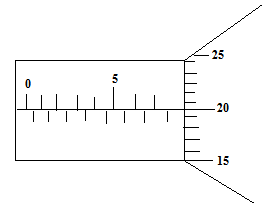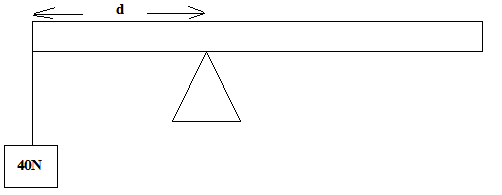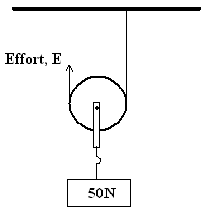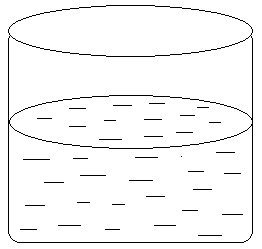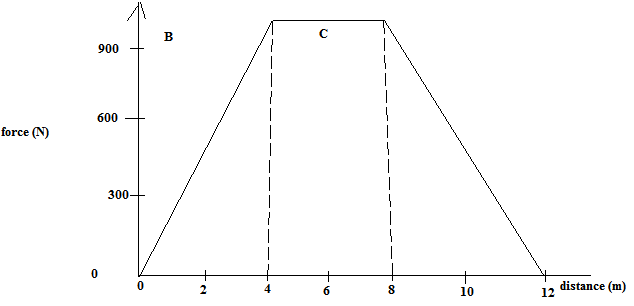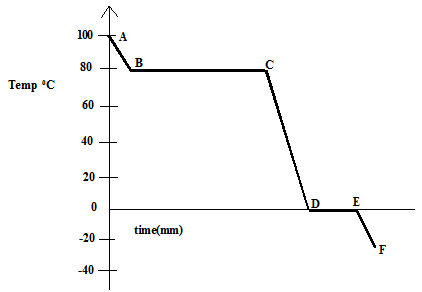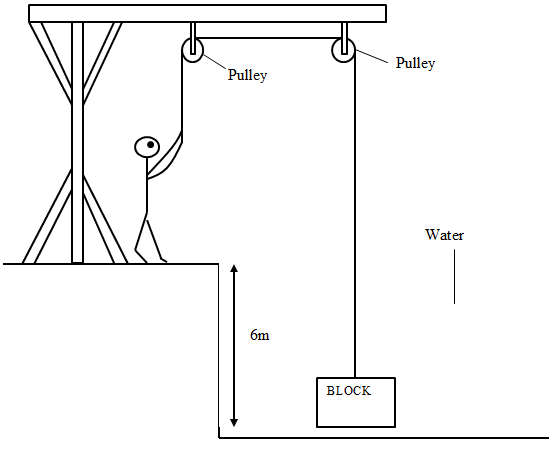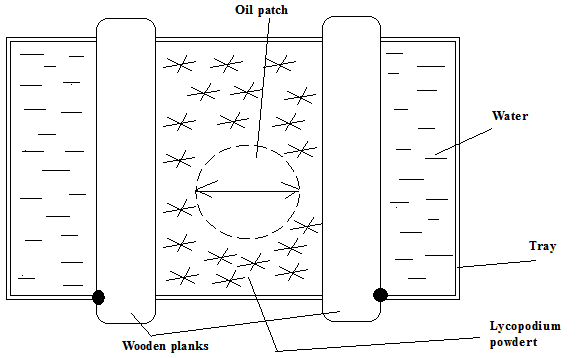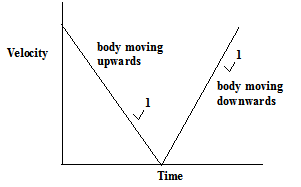INSTRUCTIONS
- This paper consists of two sections A and B.
- Answer all the questions in the spaces provided.
- All workings must be clearly shown.
- Mathematical tables and silent electronic calculators may be used.
SECTION A (25 MARKS)
- The figure below shows a micrometer screw gauge. What is the reading shown on the figure. (2 marks)
- State pressure law. (1 mark)
- State two factors that affect stability of a body. (2 marks)
- The diagram below shows a uniform wooden plank of length 4m and weight 10N. The plank is held at equilibrium by a weight of 40N placed at one end as shown below.
Determine the distance d. (3 marks) - Figure below shows a non-viscous fluid that is not compressible moving through a pipe of varied cross-sectional area.
If the area of the narrow region is 0.05m2, calculate diameter of the wider region. (3 marks) - State one use of thermal expansion. (1 mark)
- State two factors that affect melting point of a substance. (2 marks)
- A body is projected vertically upwards from the top of a building. If it lands on the base of the building. Sketch the velocity-time graph for motion. (2 marks)
- State a reason why transfer by radiation is faster than by conduction. (1 mark)
- The pulley system in the figure below supports a load of 50N.
Given that the efficiency of the system is 80% calculate the effort, E. (3 marks) - The figure below shows a glass container with cross-section area of 50cm2.
When a wooden block of mass 120g is immersed into the water it floats while fully submerged and the water level rises by 4cm, determine the density of the water. (3 marks) - Define the term momentum. (1 mark)
- What is a pitch of a screw. (1 mark)
SECTION B
- The figure below shows the motion of a trolley on ticker timer. The ticker has a frequency of 100Hz.
-
- Calculate the initial velocity between A and B. (3 marks)
- Calculate the final velocity between C and D. (3 marks)
- Calculate the acceleration of the trolley during the motion. (3 marks)
- Figure below shows a force-distance graph for a car being towed on a level ground.
- Calculate the total work done. (3 marks)
- If the velocity just before reaching point C is 0.6m/s. Calculate the power developed by the engine at this point. (2 marks)
-
-
- A metal ball of mass 100g is dipped into boiling water at 100°C and then placed in a calorimeter containing 80g of water at 20°C. After stirring, the temperature of the mixture stabilizes at 23.4°C. Ignoring the heat gained by the calorimeter, determine the specific heat capacity of the metal. (Specific heat capacity of water = 4200j/Kg K). (4 marks)
- The cooling curve below is for a pure substance.
- What is the melting point of the substance. (1 mark)
- State two factors that affect boiling point of a substance.
- At what part of the curve is the substance.
- Solid only?
- Liquid only?
- Solid and Liquid? (3 marks)
-
- State Newton’s second law of linear motion. (1 mark)
- The legal speed limit on motorways is approximately 30m/s. In an incident on a motorway, a car of mass 900kg leaves a skid mark 75m long when stopping. The maximum deceleration of the car when skidding is approximately 10m/s2.
- Show that before the incidence, the car must have been travelling above the legal speed limit. (3 marks)
- Calculate for this skid, the maximum average braking force between each of the four tyres and the road. (3 marks)
- When the motorway is wet, the braking force provided by each wheel is reduced to 50% of the calculated in (ii) above. What is the effect of this reduced breaking force on stopping distance, explain your answer. Assume that the speed of the car before breaking is the same in both cases. (2 marks)
- A student carried out an experiment to measure static friction using identical wooden blocks arranged as shown in the figure.
State and explain which spring balance will indicate a smaller reading when the block just starts to move. (2 marks)
-
- Give a reason why people experience nose bleeding when they climb tall mountains. (1 mark)
- The diagram shows a person raising a concrete block from a river bed by using two pulleys.
As shown in the diagram, the top of the block is 6.0m below the water surface. The density of water is 1000kg/m3 and the acceleration of free fall is 10m/s2. Calculate the water pressure acting on the top of the block. (3 marks) - The block is raised through water. At one part, the water pressure acting on the top of the block 4.5 x 104 pa. The area of the top of the block is 0.015m2. Calculate the downward force exerted by the water on top of the block. (3 marks)
- When the block is clear of the water, it is raised a further 4.0m. The weight of the block is 550N. Calculate the work on the block as it is raised the 4.0m through air. (3 marks)
- The figure below shows part of an experiment set up to estimate the diameter of an oil molecule.
-
- Describe how the oil patch is formed. (2 marks)
- What is the role of the Lycopodium powder. (1 mark)
- An oil drop of average diameter 0.7mm spreads out into a roughly circular patch of diameter 73.5cm on the surface of water in a trough.
- Calculate volume of the drop in mm3. Take (π = 22/7) (3 marks)
- Calculate the area of the patch in mm2. (2 marks)
- Calculate the thickness of the oil molecule and express your answer in standard form.
(2 marks)
-

MARKING SCHEME
- Main scale reading 7.50mm
Thimble scale 20 x 0.01 = 0.20
7.70mm - State pressure law state that the pressure of a fixed mass of a gas is directly proportional to it’s absolute temperature provided volume is kept constant.
-
- Position of the C.O.G.
- Base area of support
- Clock wise moment = anticlockwise moment
40 x d = 10 (2 − d)
40d = 20 − 10d
40d + 10d = 20
d = 20/50
= 0.4m - A1V1 = A2V2
A1 x 0.1 = 2.2m/s x 0.05
A1 = 2.2m/s x 0.05
0.1
= 1.1m2 - To measure temperature using a thermometer - mercury inside expands and contracts
-
- Pressure
- Impurities
-
- Radiation does not require material medium for it to transfer heat. Conduction you need a material medium.
- V.R = 2
80/100 = M.A/2
M.A = 1.6
M.A = L/E
1.6 = 50/E⇒ E = 50/1.6
E = 31.25N - Density = Mass
Volume
= 120g
50 x 4 cm3
= 120g
200cm3 = 0.6g/cm3 - Product of mass of a body and velocity (P = m x v)
- This is the distance between two successive threads of a screw.
-
-
- VAB = distance
time
= 0.5/0.01s = 50m/s2 - VCD = distance
time
= 5.0cm = 500m/s2
0.01s - acceleration = v - u
t
= 500m/s - 50m/s
5 x 0.02S
= 4500m/s2
- VAB = distance
-
- Work done = Area under the graph
= (½ x 900J x 4m) + (900 x 4) + (½ x 900 x 4)
= 1800J + 3600J + 1800J
= 7200J - Power = force x velocity
= 900J x 0.6m/s
= 540 Watts
- Work done = Area under the graph
-
-
- Heat lost by the metal = heat gained by cold water
0.1kg x C x (100 - 23.4)K = 0.8kg x 4200 x (23.4 − 20)K
C = 0.8 x 4200 x (23.4 − 20)
0.1 x (100 − 23.4)
C = 1491.38JKg−1K−1 -
- 800C
-
- Impurities
- Pressure
- Solid only - EF
Liquid only - BC
Solid and liquid - DE
- Heat lost by the metal = heat gained by cold water
-
- The rate of change in momentum is directly proportional to the force causing it and it takes place in the direction of the force.
-
- V2 = u2 + 2as
V2 = 0 + 2 x 10 x 75
V = 38.73m/s - F = ma
= 900 x 10
= 9000J (total for four tires)
Braking force for each tires = 9000J =2250J
4 - The breaking distance will increase because wet road offers less frictional force which is required for breaking.
- V2 = u2 + 2as
- Spring balance B rollers reduce friction between the surfaces.
-
- Atmospheric pressure decreases with altitude, pressure inside the body overcomes atmospheric pressure causing weak veins to burst.
- P = Pgh
= 6 x 100 x 10
= 600N/m2 - F = PxA
= 0.015m2 x 4.5 x 10 pa
= 675N - Work done = Force x distance
= 550N x 4M
= 2200J
-
-
- When the oil is dropped on the water surface, it lowers it’s surface tension, this causes the powder to move away this forming a patch
- To make the oil patch visible
-
- V = 4/3π0r3
= 4/3 x 22/7 x (0.7/2)3
= 4.19mm3 - Area = πr2
(73.5/2)2 x 22/7
= 1155mm2 - Thickness (t) = Volume of oil drop
Area of the patch
= 4.19mm3
1155mm2
= 3.6 x 10−3mm
- V = 4/3π0r3
-
Download Physics Paper 1 Kenya High Post Mock Exams 2020 - Questions and Answers.
Tap Here to Download for 50/-
Get on WhatsApp for 50/-
Why download?
- ✔ To read offline at any time.
- ✔ To Print at your convenience
- ✔ Share Easily with Friends / Students

